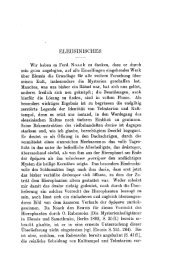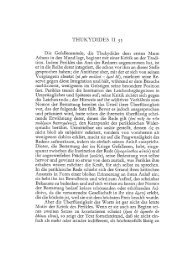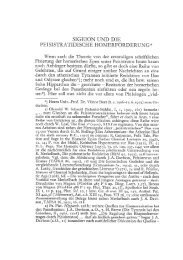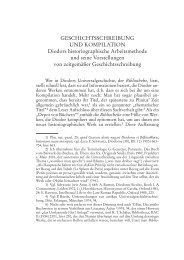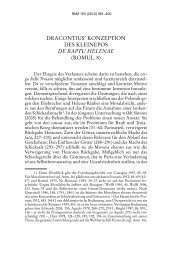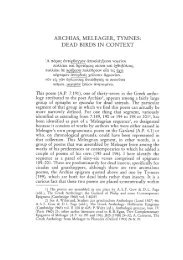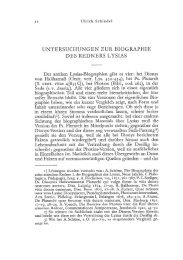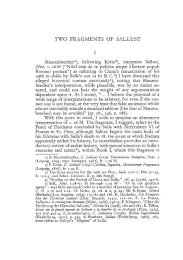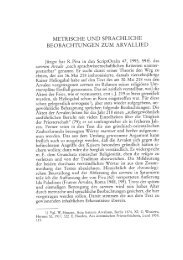APOTELESMATICA 2. (1) 14–140: SOURCES AND MODELS*
APOTELESMATICA 2. (1) 14–140: SOURCES AND MODELS*
APOTELESMATICA 2. (1) 14–140: SOURCES AND MODELS*
Create successful ePaper yourself
Turn your PDF publications into a flip-book with our unique Google optimized e-Paper software.
92 Maria Ypsilanti<br />
sources the author uses, 56 but also due to his taste for elegant variations.<br />
The application of the epithet briarÒw to Ophiouchus (l. 77)<br />
is of a particular interest, as it seems to be not only a description of<br />
a vivid artistic representation (cf. above, p. 78), but also a deliberate<br />
allusion to Arat. 577 mogerÚn ÉOfioËxon, where mogerÒw “refers to<br />
the effort involved in controlling the serpent” (Kidd ad loc. ). What<br />
is more, podÚw y°nar ÑHniÒxoio (l. 81) is a direct reference to Arat.<br />
718, where the rare in literature y°nar podÒw is applied exactly to<br />
the Charioteer’s foot. The phrase y°reow purilamp°ow Àrhn (l. 72),<br />
apart from recreating a Hesiodic atmosphere (see below, p. 95), is<br />
an imitation in opposition of Aratus 850 and 977 xe¤matow Àrh.<br />
As far as the account of the constellations of the Equator<br />
(Apot. <strong>2.</strong> [1] 83–92) is concerned, it is worth noting that Pseudo-<br />
Manetho’s description of Orion’s Belt and Hydra is a careful imitation<br />
with variation of Aratus’ corresponding lines: Pseudo-<br />
Manetho changes the adjectives, replacing Aratus’ eÈfegg°ow with<br />
yhroktÒnou about Orion and Aratus’ afiyom°nhw with épeires¤hw<br />
about Hydra, retaining, however, the Aratean structure of the two<br />
lines (the whole line occupied by the description of Orion and<br />
almost the same word-order, three and a half feet for Hydra in the<br />
next line).<br />
Pseudo-Manetho opens the description of the tropic of Capricorn<br />
(ll. 93–100) with sk°pteo (l. 94), often used by Aratus for the<br />
introduction of a new topic. 57 With his goËna / émfÒterÉ ÑUdroxÒou<br />
ka‹ KÆteow efinal¤oio / oÈrÆn, the author of the Apotelesmatica<br />
offers a variation of Aratus’ chiastic expression about the Waterpourer<br />
and the Beast in the description of the same tropic in the<br />
Phaenomena (l. 502). 58 Now the description of Argo (ll. 97–8 ±d¢<br />
ka‹ ÉArgoËw / pontopÒrou . . . êkra kÒrumba), apart from suggesting<br />
an artistic representation of the ship on a globe the author has in<br />
front of him (see above, p. 82), also echoes Aratus 686 êkra kÒrumba<br />
. . . poluteir°ow ÉArgoËw. 59 ÉEstÆriktai, used by Pseudo-<br />
56) For this, together with the Aratean passage, see above, under Astronomical<br />
sources.<br />
57) Lines 778, 799, 832, 880, 892, 994 (see Kidd on 778), always at verseopening,<br />
as in the present passage of the Apotelesmatica.<br />
58) Which echoes that of Eudoxus, ofl pÒdew toË ÑUdroxÒou ka‹ toË KÆtouw ≤<br />
oÈrã (fr. 73,10 f., cf. Kidd on 502).<br />
59) A Homeric echo (Il. 9.241), kÒrumba being a Homeric ëpaj legÒmenon,<br />
see further Kidd ad loc.



